The third in my recent triptych of all-road bikes, the Caledonia-5 was conceived and named after a poorly surfaced road outside Cervelo’s Toronto headquarters. The story goes that the road was used as part of the company’s after-work rides but wasn’t entirely suitable for the brand’s race thoroughbreds like the R5 and S5, so they designed a fast bike with plenty of speed and excitement that could still handle the cracks and potholes of Caledonia Street.
As such, while it does make some concessions to comfort and endurance it does so without losing sight of its race heritage – Cervelo says that it is a bike intended for ‘Big, Stupid Rides’ where the goal isn’t just to ride large distances but to do it rapidly as well.
Five years ago, when the Caledonia model was first introduced, it was somewhat unusual in this aim and although there are alternatives available now it is still a class-leading bike. Cervelo originally made the Caledonia and the Caledonia-5, with the -5 denoting a better and lighter carbon layup and more premium components; this is the updated version of the -5, while currently, the basic Caledonia remains unchanged.
It is available as frame only, or built up with Shimano Dura-Ace Di2 and Ultegra Di2 or SRAM Red AXS, Force AXS or Rival AXS. All models get Reserve wheels except the Rival AXS model.
Construction
Clearly, Cervelo’s engineers feel they got some things right the first time around as the new -5’s carbon frame retains the same successful geometry as the previous models. Although the angles remain the same, plenty of small tweaks add up to a reasonable difference between the old and the new.
First and most obvious is the on-point inclusion of downtube storage, tucked away beneath the bottle cage. Access is slightly awkward, but once in you’ll find a couple of neoprene sleeves intended to hold tools and spares. Secondly, the frame’s shape is subtly different with the seat stay/seat tube junction set slightly lower and the head tube a bit deeper for improved aerodynamics. And thirdly, there is now clearance for 36mm tyres, or 34mm with full mudguards. There is (of course) the usual chat about it being stiffer with more compliance, especially around the bottom bracket area.
The new Caledonia-5 boasts a slightly deeper headtube for improved aerodynamics
(Image credit: Tim Russon)
The test bike is equipped with SRAM’s second-tier Force AXS groupset, using the largest 36-tooth cassette available and a 48/35 tooth chainset to give a huge range of gears without too many jarring jumps between the ratios, perfect for tough hills at the end of long days out. The chainset also includes an integrated power meter for riders who love a bit of data. SRAM’s shifting mechanism, with one large paddle on each side, is simplicity itself and very easy to use when tired or wearing gloves.
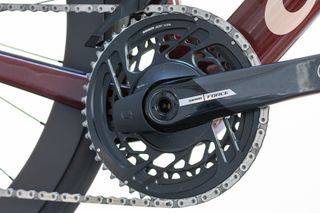
Low gears and integrated power meter
(Image credit: Tim Russon)
Reserve is kind of Cervelo’s in-house wheel brand, which allows it to spec premium carbon wheels within the bike’s price point. The 42/49 Turbulent Aero wheels are one of the newest offerings from Reserve and use a very wide design with a 25.4mm internal width rim on the front and a 24.8mm on the rear whilst the front’s external width of 34.4mm is noticeably huge. These widths allow the 30mm Vittoria Corsa N.EXT TLR tyres to balloon out to over 33mm on the front and not much less on the rear.
A D-shaped, inline carbon seat post, Selle Italia Novus Boost Evo Superflow Ti saddle and carbon handlebar complete the bike’s details. Some riders will be pleased to see a separate stem and handlebar rather than a one-piece design, but the hydraulic hoses still route through the stem making life trickier if you need to swap stems.
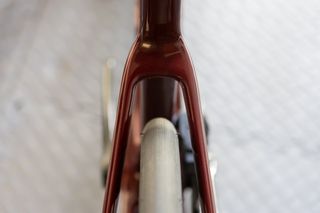
Plenty of tyre clearance, with or without mudguards fitted
(Image credit: Tim Russon)
As mentioned, the geometry is unchanged with fairly typical endurance style numbers compared with a performance bike – longer wheelbase, slacker headtube and stretched chainstays. However, the differences are pretty small, hinting at racy pretentious. Weightwise, the 56cm Caledonia-5 registered just over 8kg on my scales which is more than reasonable given its remit. The ‘Carmine’ (maroon and rose gold) paint job grew on me over time, in a subtle, classy way but didn’t garner as many compliments as the ‘Oasis’ (sparkly green/blue) colourway on my own Caledonia.
It is available as frame only, or built up with Shimano Dura-Ace Di2 and Ultegra Di2 or SRAM Red AXS, Force AXS or Rival AXS. All models get Reserve wheels except the Rival AXS.
The Ride
I bought one of the original, basic Caledonia’s for use as a winter bike and for tarmac bikepacking, and I am still very happy with it, so I was fully expecting the new Caledonia-5 to feel pretty familiar. I mean, how much difference can a bit of carbon and a tweak or two make?
Quite a lot as it turns out. The new bike feels much, much quicker.
The -5 has an incredibly free-rolling feel to it, almost as if every bearing and chainlink has been fully optimised making it more efficient and rapid than my older version. Clearly, the new frame’s stiffness and improved carbon layup will have something to do with it, but I also think that the excellent Reserve wheels and wide tyres can take some credit as well. As our roads in the UK get ever worse, larger tyres on a road bike make more and more sense, and with the Caledonia riding on effectively 33mm rubber, it is not surprising that it feels relatively untroubled by poor tarmac.
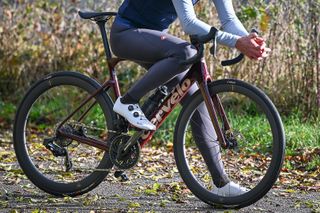
The Cervelo Caledonia-5, versatile and rapid
(Image credit: Andy Jones)
That isn’t to say in any way that it feels turgid to ride though – quite the opposite. The frame feels stiff and efficient with the wide tyres simply knocking the edges off the worst effects of the roads rather than the bike wallowing along. There is a solid feel to the ride which doesn’t isolate you from the road in the way that the Ribble Ti Allroad did, rather the Caledonia-5 lets you know that you hit something, but doesn’t allow it to affect your progress. This makes it feel far more spritely and rewarding than some allroad-labelled bikes – it had no trouble at all keeping up with race-bred machines on the club run.
With tyres that wide, it’s little surprise that the bike felt superbly planted when descending and not much could knock it off course once leant into a corner. The long wheelbase helped too, but didn’t hold it back spinning uphill. Much like the Dogma X, it was better to stay in the saddle and tap out a rhythm rather than stand up and wrestle with it on climbs. Cruising along my position on the bike was great, but when pressing on I would have preferred the potential to get a little bit lower and longer at the front.
The hooked Reserve wheels were lovely – light, stiff and aesthetically pleasing. Setup tubeless with full-on performance tyres I think that they would really shine and give the bike even more suppleness and speed. The rim shape, width and height are different front and rear (hence the 42/49 name), and although light, they have been raced at Paris Roubaix so they aren’t lacking in strength. In fact, they have no rider weight limit.
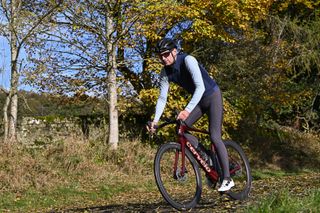
The Reserve wheels and 33mm tyres provide a solid ride feel, yet one that never feels turgid or slow.
(Image credit: Andy Jones)
The SRAM gear ratios allowed most riding to be done on the big ring, which was nice, and the cassette’s 10-tooth sprocket ensured that there was no shortage of top-end speed when required. At the very top of the 12-speed cassette, the last couple of jumps interrupted cadence a little but throughout the rest of the ratios it was very smooth. Force’s latest hood design is smaller and less bulbous than previous versions although they are still not as neat as Shimano’s Di2 shape, and I found them perfectly comfortable. Braking performance was fine, but perhaps lacked some of the Shimano’s bite.
For me, the main misfire is with the downtube storage. I’d imagine that it took a fair bit of time and money to engineer enough stiffness in the frame to allow a great big hole to be cut out of it, probably adding a bit of weight in the process. When I first set up the bike, I attached my usual, basic Elite bottle cages only to realise that the cages’ shape wouldn’t allow the storage to open so I had to hunt around for some different shaped ones. To compound the frustration, Cervelo has used lightweight aluminium bolts with 3mm hex fitting – two of these rounded off despite my best efforts and decent Allen keys.
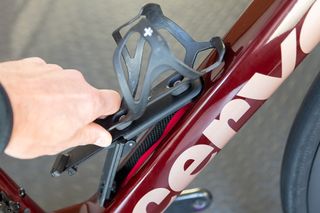
Make sure you have the right kind of bottle cages
(Image credit: Tim Russon)
When I did get it all set up, I ferreted out the neoprene sleeves and started to fill them with my ride gubbins, but I had to cull some tools and spares as there wasn’t enough room for my tool tub’s worth. It is a relatively minor point, and you don’t have to use the storage, but it didn’t seem like a particularly good execution of the concept and personally I’d rather they hadn’t bothered. At the very least, Cervelo could supply suitable bottle cages with each bike.
In over 500km and counting the Cervelo Caledonia-5 was always fun and easy to ride. Whether I was at maximum effort on a Sunday club run or cruising through the Peak District collecting my thoughts, it didn’t put a foot wrong and actually inspired me to go out and ride on a few occasions when I was less than keen. I was really surprised at the difference between the new -5 and my older, basic Caledonia.
Value and conclusion
I really, really liked the Caledonia-5. It seems like the almost perfect combination of speed and comfort for UK roads; a slightly detuned race bike rather than a back lanes plodder, which makes complete sense given its origin story. If it weighed slightly less and had a little lower stack height I would be very tempted to buy one for year-round use – make use of the clever, hidden mudguard mounts in the winter and strip it down in the summer.
At £7,400 it can’t be considered a bargain, but there is precious little need to upgrade anything as Cervelo hasn’t skimped on the spec and it rides so damn well that it is decent value. Given that of the other two allroad bikes I’ve ridden recently one is nigh on twice the price and the other doesn’t feel anywhere near as rewarding to ride, I have no doubt at all where my money would go. I know it’s sacrilege to stray from the N+1 path, but if I could have only one bike for winter duty, bikepacking trips, epic rides and club chaingangs, the Caledonia-5 would be very high up on my shortlist.